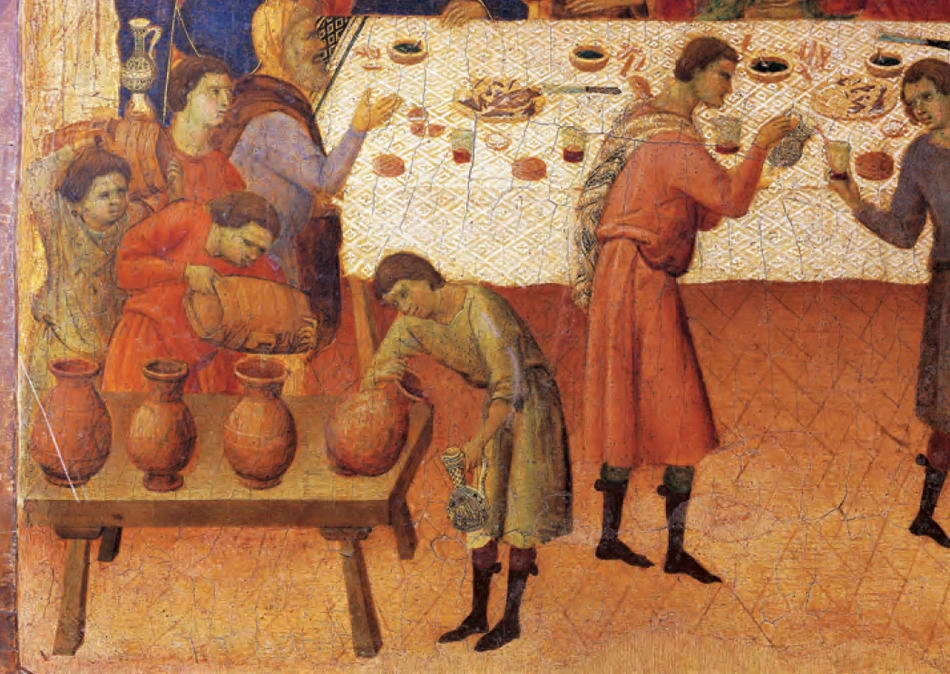Emily Kate swirls a glass of red wine and deeply breathes in its fragrance. A small silver cluster of grapes hangs on a chain from her neck, flashing in the sun that is pouring through the atrium’s towering wall of windows. Kate, who is a falconer and archer as well as an enologist, has just walked past some medieval tapestries, and is talking about the importance of their depictions of winemaking scenes. “Much of what we know about vintage in the early Middle Ages is confirmed by these tapestries,” she says. “The main material for storage in the medieval wine industry was wood, as opposed to clay, and has since been destroyed, unlike the terra-cotta artifacts in the Ancient wing.”
The more you hang around Kate, the more you get the sense of a kind of Gothic woman stuck in the modern world.
Kate, a Columbia senior majoring in medieval history, has been coming to the Metropolitan Museum of Art this summer for a Columbia class called Impressionism in New York. But today, sitting in the museum’s Petrie Court Café, she has her own agenda. “I tell my college friends if they forget what to do in the middle of a tasting, just sing the kids’ song ‘Head, Shoulders, Knees, and Toes’ and remember to go down your face the same way: eyes, nose, mouth,” Kate says. She lists aroma characteristics — fruit, spices, and oak — and stops on the word jamminess. “This just means jam, as in cooked fruit. When a grape is grown in an area that’s too hot for that variety, it just tastes jammy!”
This morning, Kate stood in the Bothmer Gallery, among the Athenian vases and amphorae from circa 400 BC, monitoring Twitter for reactions to an article she’d written for the online magazine Grape Collective. Most people in the gallery were simply passing through, on their way to view mummies or the moderns. But hearing Kate’s enthusiasm as she spoke about these black-and- rust-colored vessels made even casual wanderers come closer and listen.
“There were four different kinds of kraters used for mixing water and wine — they were rarely consumed separately,” Kate said, gesturing toward the large vases behind the protective glass. “And most of the wine was terrible. Probably only the very rich would have wine that could be sipped without water.” The water quality in the ancient cities was poor, and the wine acted as an antiseptic. “Everyone from babies to old people drank wine all day long, just because it was the only thing available to drink.”
Although this practice would never get the surgeon general’s recommendation, it turns out the wine proclivities of the ancient Romans and Greeks were not so different from ours. For example, they liked to drink chilled rosé in the summer, though the chilling took some extra effort. Kate explained that in the winter the Romans would dig ditches deep in caves outside the city and pack them with snow and hay. When summer arrived, they would return to the caves and chip away at the ice blocks that had formed, shuttling the shavings down to the city for a steep price so people could cool their drinks. “The result was something like a wine slushy,” Kate said. “Kind of like those Italian ices on the streets of New York City.”
This is Kate’s forte — linking our modern world with antiquity, using wine as a bridge. Back at the café, she thunks some musty library books onto the bar next to the cheese plate. “I love Butler Library — I can’t go anywhere without my books.” She pages through illustrations of hieroglyphs, which she recently used to decode information from Egyptian wine jars found in King Tut’s tomb. “The ancient wine labels put our modern ones to shame,” she says, noting that often the jars would include the style of wine, type of grape, year, winemaker, king’s reign, vineyard, and more. Kate, who works part-time in an Upper West Side wine shop, calls today’s labels “confusing,” and bemoans the lack of standardization in the contemporary wine world. The vessels from Tut’s time offer historians a gold mine of data, including a star system to rank quality, and also a general sense of what the wine might have tasted like. Not so in today’s typical wine shop, which is full of bottles with pretty art and few consistent details that allow you to compare one bottle with another. “You basically just have a bunch of bottles and no idea what’s in them,” Kate says.
Kate aims to go into cellar management — a kind of personal curatorial service for wine collectors — though her true love is winemaking. She first stumbled into a vineyard on a tour of the Italian countryside with her mother while taking some travel time off from Columbia. They stayed a few weeks in a pension with its own vineyard, where Kate experimented, mashing different grapes together and learning the process from the family. After that, she took winemaking internships at vineyards in Australia and Long Island. “I was basically a farmer in a black cotton dress and big boots, since you get splashed all day,” Kate says.
More recently, Kate has been engaged in what might be called wine activism. When a magnitude 6.0 earthquake struck the wine country of Napa Valley in late August, rupturing tanks and destroying barrels and bottles holding thousands of gallons of maturing wine, Kate sprang into action in a decidedly contemporary way.
“The cleanup and relief efforts needed to be organized quickly,” she says. “Social media is especially important in the wine industry because it allows for this global group to connect instantaneously.” From morning till midnight the day of the earthquake, she was busy on social media reposting images of the destruction from the winemakers’ Facebook pages and encouraging those in the area to volunteer at the cleanup. She also instructed wineries in how to create their own crowdfunding accounts. “By the next day,” she says, “many online support systems had been put into place, including a forum to match willing and qualified industry volunteers with wineries in need.”
It’s a long way from the Middle Ages. Back then, in the fall, wine drinkers would spill the remainder of their wine out in the streets in anticipation of the new vintage. “In contrast to today and antiquity,” Kate says, “there was no such thing as aging wine, as it would readily spoil due to the medieval adoption of the wooden cask, which wasn’t airtight like the ancient amphora.”
As she completes her studies, Kate continues to sell wine and advise customers at Gotham Wines & Liquors, honing her tasting skills so she can one day spend solitary hours curating collections in dark caves and cellars. Which in some ways isn’t so different from passing her days in Butler.
“This past year has been somewhat monastic,” she says, giving her Malbec one last swirl. “But studying history is studying people. It is a type of companionship.”



